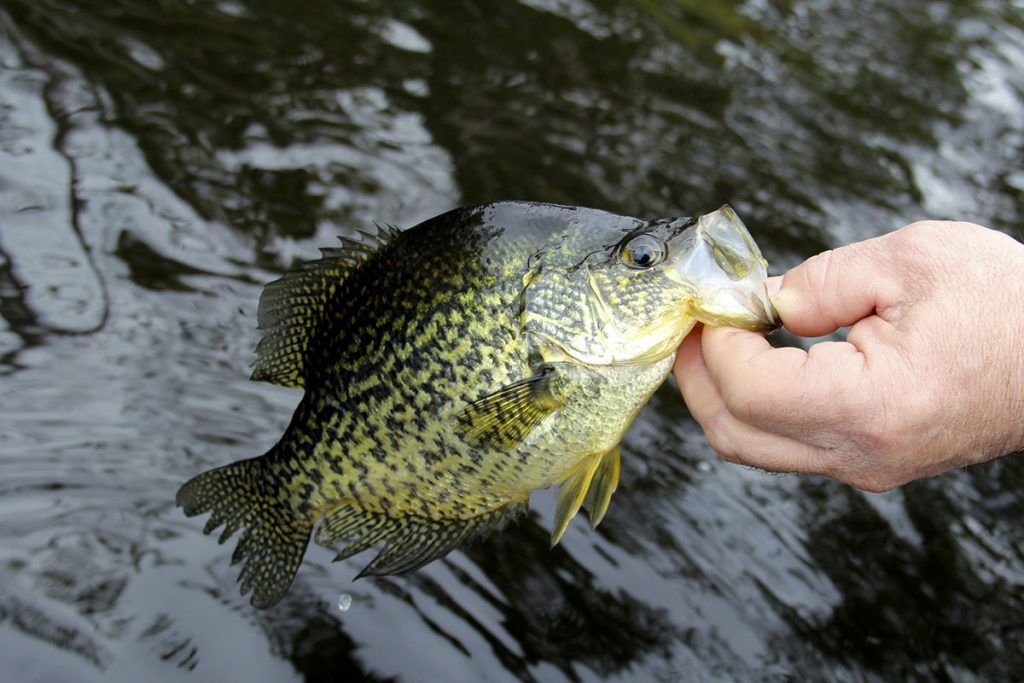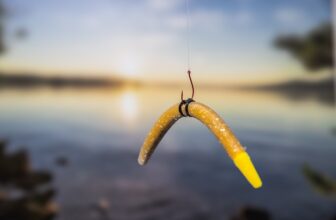
Crappie are undoubtedly one of the most popular species of game fish in the waters of the United States for plenty of reasons. They can be found in abundant numbers in most large lakes and reservoirs. When you do locate a large school of crappie, it’s not uncommon for anglers to catch their limit while sitting in one spot for many hours. Professional crappie anglers use mostly the same tactics that the average angler usually does, but there are a few small aspects of these rigs that they often adjust based on the fish’s depth or weather conditions. In this article, we will discuss some of the most popular crappie fishing tips and explain why they are so often used by the pros and how you can add them to your crappie fishing strategy this season.
Crappie Fishing Rigs
Bobber and Minnow Combo
One of the most commonly-used crappie fishing tips is one that anglers have relied on for many generations—the classic bobber and minnow approach. This method of fishing isn’t just for young kids or old retirees who sit on the bank at your local public lake. Professional crappie anglers are well-acquainted with this fishing method and know that it is arguably one of the best ways to fill your live well or cooler with giant slabs.
The key to this method of fishing is finding the right brush pile or downed tree where crappie are likely to be holding to. Your approach should be to sneak up on the location very quietly as it doesn’t take much noise to spook your target away for many hours before they’ll return. Once you get within casting distance, you’ll want to throw the rig in on top of the brush pile without getting snagged on it, of course.
This is a very delicate process since you’ll almost certainly ruin the spot if you get hung on a limb and are forced to plow into the spot with your boat or snatch it free. This tactic often works best during the spring months when crappie are usually engaged in their annual spawning ritual. During this time, they will congregate in schools of hundreds of fish around submerged structures along the banks that are in certain depths.
To execute this method of crappie fishing, you’ll simply need to rig a hook and possibly a small split-shot sinker on the line with a bobber attached about 1 or 2 feet above the hook. Most crappie pros prefer to hook their minnow on the back end behind the dorsal fin, which will allow the bait fish to swim around and do a better job of attracting your target.
Many anglers prefer to use a longer rod for this method of fishing. The general consensus is to use a rod that’s at least 7 feet in length, but some pros will opt for a rod that’s 10 or more feet in length.
Trolling with Jigs
Another highly productive crappie fishing tip that pros and guides will employ is trolling with jigs. This method works quite well in the fall or spring months when crappie will be transitioning from deep water to shallow or vice versa. This method is popular among pros and anglers will fix multiple rods to a platform on the stern that features them spread out in a way that resembles a spider’s legs stretching out from its body.
This method of fishing requires that you simply sit back and watch the rods for a bite. The true skill involved comes with being able to use your trolling motor and fish finder in conjunction to make large, sweeping passes across certain areas. Doing this will eventually result in you locating a large school of crappie which may or may not attack the jigs.
The fish might not always strike at the passing jigs. If you make a few passes without getting a single bite, you may want to try a different combination of color with your jig and jighead. Sometimes crappie can be described as finicky when it comes to their taste in colors and a slight change can have significant results.
Spider Rigging
The next crappie fishing tip that should be noted is known as spider rigging. This method is very popular in the winter months when crappie can be suspended in deep water of 20 feet or more. Spider rigging utilizes a rod holding platform that’s very similar to what you’d use when trolling, but many anglers prefer to have their rods rigged on the front or bow of their boat.
It’s usually common for anglers to use longer rods that will help to spread their lines out a bit more and cover more of a larger area than usual. When it comes to spider rigging, most anglers typically use live minnows that are either small or medium size rigged on a simple hook and possibly a split-shot sinker.
Spider rigging works virtually year-round for crappie and can be especially productive during the spawning months and early summer. In fact, during the spawn, pro crappie anglers have been known to have success using a spider rig around submerged rocks or ledges that are also near standing timber. Shortly after the spawn, when crappie will be moving back toward the deep, spider rigging is often thought of as the only method that truly works.
The best time for spider rigging is late winter or early spring. Crappie will be aggressively feeding just before the spawn and will be moving toward shallow areas. This is usually a time when pro crappie anglers know exactly where the crappie are headed to based on years of experience in the particular lake they fish. Once you eliminate those variables, it’s easy to see why spider rigging has become so popular in recent years.
Pitching Jigs
Another very common method and popular crappie fishing tip is pitching jigs in or around submerged cover. This method is highly effective just before the spawn when crappie are aggressively feeding and will be looking to bite just about anything that comes their way.
The tactic of pitching jigs also works at any time of the year if you’re able to locate a large brush pile that’s submerged in about 15 to 20 feet of water. Anglers will set up outside and cast their jig out so that it runs right by the brush pile, which will bring the fish out.
There are virtually endless combinations of jigs and jig heads that you can use together. Many anglers prefer to use a jig that features a small spoon, which will help to entice the fish to bite when the water is especially murky or dark-colored.
This method of crappie fishing can be extremely effective in the late winter and early fall. If you manage to locate a school of crappie at this time, they will likely be feeding in preparation for the spawn. Pitching jigs is a great strategy for catching large amounts of crappie, but it might not always produce the giant slabs that most pros are after once the spawn is over. In the late spring, when the spawn has happened, this method will still produce lots of bites, but they will mostly be from the smaller male crappie who have stayed behind to guard their eggs.
Shooting Jigs
The next method we’ll mention is commonly referred to as shooting or skipping jigs. This method is commonly used with a 1/16 ounce jig since you’re actually trying to ‘skip’ it across the top of the water toward your target much like you would a flat stone. Some anglers have managed to accomplish this feat with a ⅛ ounce jig, but those are normally too heavy and will quickly bury down into the water before reaching your target.
This crappie fishing tip works during the warmer months when fish will be seeking refuge from the sun and the heat. Much like humans and other animals, crappie will seek out shade when the sun begins to get higher in the sky. Instead of sitting in the bright sunlight and sweltering heat, crappie will find some kind of cover in the form of trees, docks, or other structures and hang out in the cool water shadows.
You’ll need to have at least a 6 ½-foot rod or longer that features a limber tip. This will allow you to use the tip to literally ‘shoot’ your jig at the target and skirt underneath any low hanging branches or docks.
You’ll want to open the bale on your spinning reel and hold the line in the same way you’d prepare to make a cast. Instead of casting, you will simply grab the jig and pull it back to ‘aim’ it at the target while increasing tension on the rod, which will act like a catapult. Release the jig and the line at the same time and you can successfully shoot the jig at your target.
Cranking for Crappie
Most recreational anglers are unaware that crappie will often bite a small crankbait in the deep, open water. This is usually because these fish are generally thought to be suspended in the depths and many anglers assume that they are not worth the trouble to target with any sort of lure or bait. Using small crankbaits will often do the trick to entice these lone crappie to bite.
The key to this method is locating an area where you see a decent amount of crappie suspended out in the open water using your electronics. Any variation of a two-inch crankbait will usually get the job done. As usual, crappie might often be more inclined to bite lures that are certain colors, so if you don’t get a bite on your first few casts, try using a different color to see if you can coax the fish into biting.
Conclusion
Any of these methods can prove to be useful at certain times of the year. Like most other fishing tips and tactics, you’ll need to practice these methods and develop an understanding of when and why they work based on the conditions you’re fishing in. While most anglers think that crappie will only bite during the fall and winter months, you can prove that they’ll bite year-round by making use of these different crappie fishing tactics at the right times.



 Amazon.com
Amazon.com 





